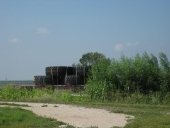posted 7 years ago
Some of the most poisonous substances used by humans, are in antifouling paint, which covers the bottom of Commercial and Military ships. These things accumulate in the bottom mud of canals, and around marinas.
I can't think of any other location more likely to produce contaminated soil, than in the bottom of a ship canal. There are likely to be heavy metals, petroleum and any other product that has ever been dumped into that canal.
Edit.
I just left a mobile view for a minute, so that I can see where you are. I doubt that Idaho has the type of ships I was talking about. Are these canals, or drainage ditches, or some other type of trench?






